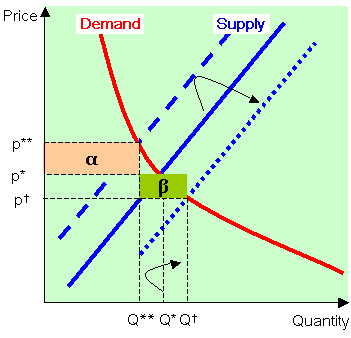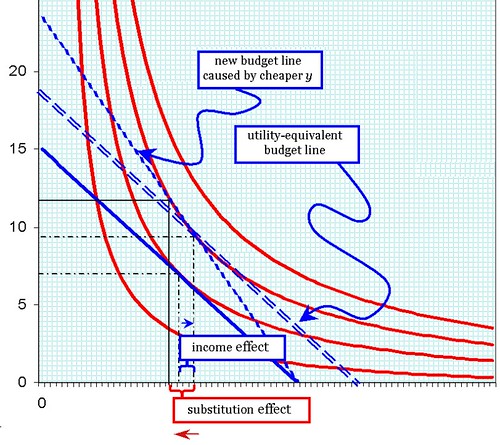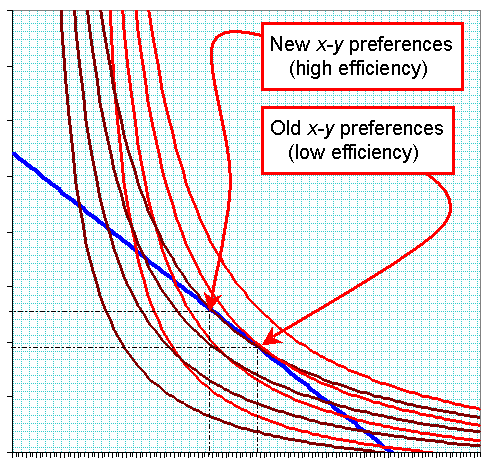With oil prices continuing to hover around $135/barrel (or €85/barrel), the speculation hypothesis has widespread support. That's the theory that high prices of commodities generally reflects illegitimate financial market activity. I'm trying to keep an open mind but none of the arguments I've seen are convincing.
To me, the big headache is establishing a mechanism by which either (a) high futures prices drive up oil spot prices, and (b) how high flows of money into the forward markets (futures & options) influence the strike price of the commodity.
(
For an introduction to this topic, see my post "Commodity Prices and Speculators.")
To some readers, these may seem like very dumb questions. If a lot of people are trying to abandon US dollars as a store of value, then they will want to buy up large tranches of oil future contracts, or perhaps options. That naturally drives up the strike price. When producers see that the strike price is rising, they naturally want to withhold stocks from the market in anticipation of still higher prices. Refiners likewise respond to the high forward prices by hoarding it. This drives prices even higher.
There are two steps to this explanation: one explains how a lot of currency flowing into commodity forward markets can drive up the strike price, and the other explains how a rising strike price can push up the spot price. Both steps are problematic. First, options can be traded at any of a wide range of strike prices.
1 At the time of this writing, Brent crude was trading at about €87 per barrel. Options must exist for €85- and €89-barrel Brent, and probable for a wide range of prices above and below that. Also, new options are written each day for spot ± €0.50/barrel, so that options are tradable from €57-89/bbl (reflecting, in other words, the range of prices over the previous six months). So it's possible for a lot of speculative money to flow into the options market at
lower strike prices. Buying an option for 100 barrels of Brent that expires in 3 months with a strike price of €68/bbl means an outlay of about €1,900; should the price fall to €80/bbl, then your loss will be €700, or 36% of your initial investment. If the strike price is €89, then the option is "out of the money," and costs very little; but then you're betting that the price will rise above €90 and stay there long enough for you to cash out.
When the market for options is extremely brisk, naturally the money goes to the people writing them: in theory, suppliers of the underlying good, but also some daredevils who may write "naked options" on [say] shipments of crude they don't own. Options can absorb immense amounts of speculative money, since anyone can write them and most will expire as worthless scraps of paper. They provide no benefit to the person writing them other than the fee and favorable price movements. Basically, they are a hedge: if you are a supplier and you write a lot of call options at the current price, you are locking in the strike price as the most amount of money you will make, but if you understand the market well, then you can reap a handsome profit when your product's price falls well below the strike price. Conversely, you might be a refiner who buys a lot of crude at the current high price; you anticipate that the price will rise even more, so you write put options and sell them to suppliers in which you promise to buy crude at €90/barrel. If the price does indeed go to €100, it sucks to be you but at least you got the money from selling the options to cautious suppliers.
Nevertheless, it's hard to see how this can influence the actual price of the underlying commodity. Writing options does allow buyers and sellers to recoup a modest amount of money from unfavorable movements of the market; when money flows from the non-financial sector into options trading, the effect is to shield options "customers" from some of the consequences of unfavorable movements (giving them time to prepare for new business conditions), while partly compensating "writers" for losses incurred by unfavorable movements.
(
See here for an exceptional scenario.)
Futures are a different matter. Taking crude oil (again) as our example, there's a global demand of about 83 million bbls. per day; supposing about 10 million bbls. are sold as future contracts well in advance. Normal derivatives traffic ensures minimal price risk to suppliers and refiners. Then, so to speak, Satan enters the garden in the form of hedge fund managers desperate to park $10 million per day of new money. The hedge fund buys a large number of futures, but it has no intention of taking delivery of all that oil; instead, when the futures near maturity, it sells them to a major (
i.e., one of the large multinational, vertically-integrated oil companies). The problem is that the oil company can choose between buying the inflated future or a lower spot price.
David Kruse, President, CommStock Investments,
wrote an editorial describing precisely this scenario:
Cash commodity markets however, run the risk of becoming the tail swung by price discovery of futures exchanges that are not based on commodity market fundamentals but on the capital investment flows in and out of the commodity sector. The connection between cash markets and respective futures markets differs between commodity markets....
When funds dominate the futures trade, a fundamental distortion can occur. We believe it has occurred in soybean prices this winter. U.S. soybean carryover was projected to reach 565 million bushels this year which eclipses the previous historical carryover record of 346 million bushels in 1998-99. Global soybean carryover is record. We could have a flat out soybean crop disaster in 2006 and not run out of soybeans next year. Why did the market call for so many more acres of soybeans when carryover was already at an all-time record? The market didn't, funds did. November new crop soybeans traded $1 above fundamental market values all winter, producing incentives for farmers to plant more soybeans which the USDA says they strongly responded to.
In this case, the mismatch produced a soybean glut (in 2006).
Over the years different
Usonian commodity futures markets have adopted cash settlements. Prior to 1982, when a future expired, you either took delivery or else arranged a cash sale of the commodity to someone who wanted it. Then the Commodity Futures Trading Commission (CFTC) allowed indexed commodities and cash settlement.
2 While CFTC regulations are designed to prevent destructive speculation, it is worth noting that massive futures trading could easily lead to suppliers learning to anticipate the market's preferences for cash settlements rather than tangible delivery; and lead to sales of contracts for several times the actual volume of goods being sold. Note that CFTC regulations are supposed to prevent this; however, the much-discussed InterContinental Exchange (ICE) based in Atlanta, Georgia, allows one to trade virtual commodities over the web in London and Dubai.
This was extremely important because futures are very highly leveraged instruments. Typically one pays about 5% of the value of the underlying commodity (so, for 100 bbl. of WTI, $675 plus premium)
3; in theory, this allows one to claim very large pools of oil for very little money. A
squeeze is a situation in which a trade
goes long by an amount that exceeds the actual physical capacity that can be loaded during the month. Then the trader claims delivery, knowing that the supplying parties will not have sufficient supplies to meet their obligations. This drives up the price, but the effect is of very short duration (usually a couple of weeks, at most).
_______________________________________
NOTES:
1 An
option is similar to a future except that options are binding on only one party, while futures are binding on both buyer and seller. A
[call/put] option is a tradable right to
[buy/sell] a commodity at a fixed price on or before a given date in the future. For an explanation of options and how they work, see "
Factors affecting Options...." For our purposes, "options" are understood to be American style,
i.e., they can be exercised at any time prior to expiration.
2 Leo Chan, "
Cash settlement and price discovery in futures markets,"
Quarterly Journal of Business and Economics (Summer 2001). The mechanism for cash settlement works like this: supposing the commodity price rose $10/unit over the period the investor held it. Rather than take delivery, the investor merely accepts a payment of $10 (minus some fee), and the supplier sells the product to another buyer for cash. Assuming the price falls by $10, the investor pays the supplier; in both cases, the transfer of money effectively cancels out the price change (as far as the supplier is concerned).
3 The premia on futures and options varies with the number of futures/options bought. Very large trades involve very small premia per contract/option. Different brokerages have very different schedules of forward premia.
Long: in finance, a "long position" in a security or commodity is a position where one benefits if the price goes up. This includes writing a naked put option, buying the underlying commodity, buying futures for delivery of that commodity, or buying call options for same commodity, are all examples of "going long" or "taking a long position."
_______________________________________
SOURCES & ADDITIONAL READING:Senate Committee on Comerce, Science, & Transportation: Hearings, 3 June 2008
"
The Role of Market Speculation in Rising Oil And Gas Prices" (PDF), Permanent Subcommittee on Investigations, United States Senate (27 June 2006)
Labels: economics, peak oil, regulation









 For several years I've heard about the industrial process of converting crops into fuel. This is called biofuel, although from the first I've been highly skeptical of the technology. The reason is that agriculture is highly energy intensive, and after burning diesel fuel in order to grow crops such as maize [corn] or oilseed rape [saffola], the product has to be chemically processed into a chemical compatible with industrial applications. This processing, or "refining," of maize/oilseed into petroleum products likewise requires more energy inputs.
For several years I've heard about the industrial process of converting crops into fuel. This is called biofuel, although from the first I've been highly skeptical of the technology. The reason is that agriculture is highly energy intensive, and after burning diesel fuel in order to grow crops such as maize [corn] or oilseed rape [saffola], the product has to be chemically processed into a chemical compatible with industrial applications. This processing, or "refining," of maize/oilseed into petroleum products likewise requires more energy inputs.

